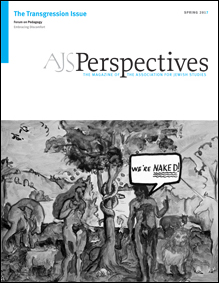Dear Colleagues,
Our first issue as editors of AJS Perspectives was on the subject of "translation," a term that originally referred to the migration of sacred relics from one location to another. With this issue, we likewise reflect on a subject that transforms spatial movement into something more existential, perhaps more threatening, difficult, and electrifying: transgression. We're not necessarily crossing lines—though perhaps, inspired by the Freedom Issue, we are—but we're thinking about those who do go beyond the pale, where boundaries come from, and what's on the other side.
Certainly Jews have historically enjoyed drawing lines, and seeing themselves on one side or the other. In the creation story in Genesis, the deity essentially tidies a cosmic mess, and this drive towards organization—a place for everything and everything in its place—permeates the book of Leviticus, which yields in turn a theology in which crossing a line becomes a sin ('averah). What precisely counts as kosher or treyf, work or leisure, who is neighbor or stranger, who is within the camp and who beyond, may vary, but the importance of the categories themselves, or at least their existence, is rarely questioned, even if only in their breaching.
But transgression can go beyond behavior and shape identity. "Hebrew"—'ivri—means "the one from the other shore" or, colloquially, "the guy from over there." "There" implies "here," and somewhere between the two, a line is crossed. "Jew"—that is, Judean, a citizen of Yehud and keeper of its traditions—is likewise a term that only makes sense in exile, outside the borders of the Land. At times, the borders around "Jewish" have been tightly drawn and fiercely guarded; at others, they have been looser and accommodating. But those boundaries of self-definition and other-definition are still enacted by their transgression. There is a sense of limit: if you eat that, think that, do that, you risk stepping beyond the label "Jew" (or at least "good Jew"—for, as it says in the Babylonian Talmud, "even when he [an Israelite] sins, he is still an Israelite" [Sanhedrin 44a], which, really, just begs the question).
This issue takes an expansive, episodic view of transgression. We asked our contributors to consider the idea of transgression broadly: in history, in literature, in the past and in the present, in the private sphere and the public, and where the two converge. We asked them to explore what constitutes transgression, and what some of the consequences of transgressing may be. We asked them to consider whether Jewish Studies is "too transgressive" or "not transgressive enough," and in our Forum on Pedagogy we asked colleagues to reflect on how discomfort—for our students or for us—can be pedagogically useful or counterproductive.
Our issue begins with addressing the intersection of the personal and the scholarly: Kavka refers to himself as "the heresy that I am," while Peskowitz confesses to liking Josephus. Levitt explores the discomfort of "Holocaust relics" while Heller discomfits with his exploration of Jewish terrorism. And, of course, it is those at the margins who most easily cross them. Sisman shares a study of rumors of deviance among the post-Sabbatian Dönmes and Frankists, who existed at the margins of mainstream Judaism; Schainker takes us into nineteenth-century taverns where Jews and Christians intermingled, and intermarried; and Ahuvia brings us back in time even as she focuses on the marginal half the Jewish population—that is, women, embracing the transgressive term, "Jewess"—and their understanding of what others would call magic. Finally, Baskind examines ways in which modern Jewish artists expand the boundaries of Jewishness in art, and Levy offers an example of how "outsiders" may, in fact, be more "insiders" than is comfortable for either supposed side.
Boundaries are often illusory, and yet the idea of transgression—the sense of a line being crossed, by one's self or another, willfully or by happenstance—can help us articulate precisely those borders that we wish to erase and those we need to redefine or reaffirm. Transgression can be an engine for creativity as well as for controversy, a source of energy as well as approbation. Indeed, at moments such as our present, when forces of conformity and doctrine and ideology speak of building walls and policing boundaries, transgression itself crosses a line from theoretical to practical. But relocation and dislocation are subject for another day.
Jonathan M. Hess
University of North Carolina at Chapel Hill
Laura S. Lieber
Duke University

